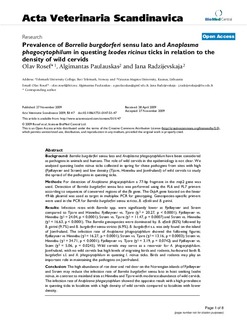| dc.description.abstract | BACKGROUND: Borrelia burgdorferi sensu lato and Anaplasma phagocytophilum have been considered as pathogens in animals and humans. The role of wild cervids in the epidemiology is not clear. We analyzed questing Ixodes ricinus ticks collected in spring for these pathogens from sites with high (Fjelløyvær and Strøm) and low density (Tjore, Hinnebu and Jomfruland) of wild cervids to study the spread of the pathogens in questing ticks. Methods: For detection of Anaplasma phagocytophilum a 77-bp fragment in the msp2 gene was used. Detection of Borrelia burgdorferi sensu lato was performed using the FL6 and FL7 primers according to sequences of conserved regions of the fla gene. The OspA gene located on the linear 49-kb plasmid was used as target in multiplex PCR for genotyping. Genospecies-specific primers were used in the PCR for Borrelia burgdorferi sensu stricto, B. afzelii and B. garinii. RESULTS: Infection rates with Borrelia spp. were significantly lower at Fjelløyvær and Strøm compared to Tjore and Hinnebu; Fjelløyvær vs. Tjore (χ2 = 20.27, p < 0.0001); Fjelløyvær vs. Hinnebu (χ2 = 24.04, p < 0.0001); Strøm vs. Tjore (χ2 = 11.47, p = 0.0007) and Strøm vs. Hinnebu (χ2 = 16.63, p < 0.0001). The Borrelia genospecies were dominated by. B. afzelii (82%) followed by B. garinii (9.7%) and B. burgdorferi sensu stricto (6.9%). B. burgdorferi s.s. was only found on the island of Jomfruland. The infection rate of Anaplasma phagocytophilum showed the following figures; Fjelløyvær vs Hinnebu (χ2 = 16.27, p = 0.0001); Strøm vs. Tjore (χ2 = 13.16, p = 0.0003); Strøm vs. Hinnebu (χ2 = 34.71, p < 0.0001); Fjelløyvær vs. Tjore (χ2 = 3.19, p = 0.0742) and Fjelløyvær vs. Støm (χ2 = 5.06, p = 0.0245). Wild cervids may serve as a reservoir for A. phagocytophilum. Jomfruland, with no wild cervids but high levels of migrating birds and rodents, harboured both B. burgdorferi s.l. and A. phagocytophilum in questing I. ricinus ticks. Birds and rodents may play an important role in maintaining the pathogens on Jomfruland. CONCLUSION: The high abundance of roe deer and red deer on the Norwegian islands of Fjelløyvær and Strøm may reduce the infection rate of Borrelia burgdorferi sensu lato in host seeking Ixodes ricinus, in contrast to mainland sites at Hinnebu and Tjore with moderate abundance of wild cervids. The infection rate of Anaplasma phagocytophilum showed the opposite result with a high prevalence in questing ticks in localities with a high density of wild cervids compared to localities with lower density. | |
